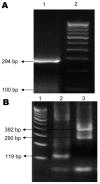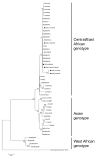Co-infections with chikungunya virus and dengue virus in Delhi, India
- PMID: 19624923
- PMCID: PMC2744227
- DOI: 10.3201/eid1507.080638
Co-infections with chikungunya virus and dengue virus in Delhi, India
Abstract
Aedes aegypti mosquitoes are common vectors for dengue virus and chikungunya virus. In areas where both viruses cocirculate, they can be transmitted together. During a dengue outbreak in Delhi in 2006, 17 of 69 serum samples were positive for chikungunya virus by reverse transcription-PCR; 6 samples were positive for both viruses.
Figures


References
-
- Shah KV, Gibbs CJ Jr, Banerjee G. Virological investigation of the epidemic of haemorrhagic fever in Calcutta: isolation of three strains of chikungunya virus. Indian J Med Res. 1964;52:676–83. - PubMed
-
- Ravi V. Re-emergence of chikungunya virus in India. Indian J Med Microbiol. 2006;24:83–4. - PubMed
-
- Gubler DJ. Dengue. In: Monath TP, editor. The arboviruses: epidemiology and ecology. Vol. II. Boca Raton (FL): CRC Press; 1988. p. 223–260.
Publication types
MeSH terms
Substances
LinkOut - more resources
Full Text Sources
Medical
